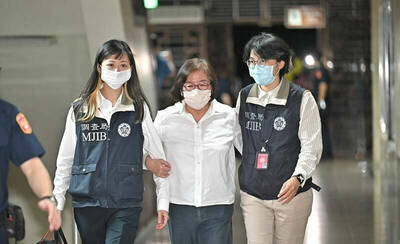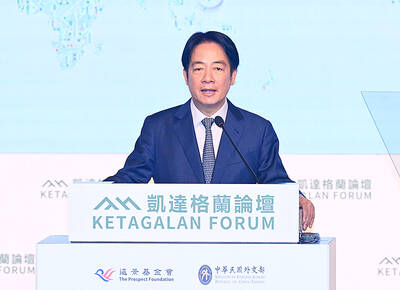There is no question that Angkor and its famed temples are among the world’s archaeological treasures, providing a window into the Cambodian dynasty that flourished there from the ninth century to the 15th century. But tourists who flock to the site in northwestern Cambodia say something is missing; few artifacts remain to help them imagine the customs and rituals of the ancient empire.
Numerous antiquities were looted over the centuries or appropriated by museums in France, the country’s former colonial ruler. Of those that remained, many were relocated to Cambodia’s National Museum, more than 298km from Angkor.
Now, a Thai company says it is trying to address the problem, opening a museum that borrows artifacts, including nearly 1,000 Buddhas, from the National Museum and elsewhere. It is just a few kilometers from Angkor Park, the sprawling area near here that is considered one of Southeast Asia’s most important archaeological sites and includes the celebrated temple known as Angkor Wat.
But the museum, Angkor National Museum, which opened in October, has already drawn criticism from powerful detractors. The critics include international restoration specialists who are fiercely concerned about anything that affects Angkor, which was restored by the UN Educational, Scientific and Cultural Organization, or UNESCO, and others after the wars of the 1970s.
Some quibble with the museum’s aesthetics — it includes a sprawling retail area — and with its sense of history. There are hundreds of Buddhas, for instance, that date back no further than the 20th century.
Other critics object to the Thai involvement; Angkor was once under Thai control, and Cambodians remain suspicious that Thailand retains designs on their patrimony.
Those suspicions were stoked in 1999 when large sections of walls with bas-relief images of the revered multiarmed figure Lokeshvara were looted from the 12th-century Banteay Chhmar temple near the Thai border. The stolen art was intercepted by the Thai police and returned to Cambodia.
Then in 2003, anti-Thai riots broke out in Phnom Penh, Cambodia’s capital, after a Thai actress was reported to have said that Angkor Wat still belonged to her country.
One of the critics, Darryl Collins, a historian based in Siem Reap, said the displeasure of some Cambodians was understandable. An enterprise that is foreign-led and “primarily interested in turning a profit,” he said, can hardly be called national, especially when Cambodia already has a National Museum.
Angkor National Museum was created by Vilailuck International Holdings, which is based in Bangkok. For 16 years Vilailuck’s parent company, the Samart Corp, has been a major investor in Cambodia’s telecommunications sector.
Under the terms of its contract with the Cambodian government, the company agreed to transfer control of the museum to the government after 30 years in exchange for the right to display treasures from the National Museum and from the Conservation d’Angkor, a national trove of some 6,000 artifacts. That collection includes important statues of Buddha from several historical periods.
The Thais involved in the museum have been stung by the criticism of the project, which Vilailuck spent US$15 million to build.
“We want to educate Cambodian people about their own history,” said the museum’s managing director, Sunaree Wongpiyabovorn. There are those “who know little about its monuments, and even less of the progress of Buddhism and what led up to it,” she added.
Wongpiyabovorn is especially sensitive to allegations that the company is motivated by economics. She said that Vilailuck had to triple its original investment of US$5 million because of cost overruns and did not expect to see a profit for at least 10 years.
Moreover, complications seem to have left the Thais frustrated, especially with regard to the terms and conditions of the loans. Under the original plan, the former director of the National Museum, Khun Samen, agreed to hand over as many as 1,000 artifacts during the 30-year contract, as well as 31 major pieces for a six-month loan.
His successor, Hab Touch, reduced the number of major pieces to be shared to 23. “I am not going to surrender important pieces that should be permanently displayed here for the integrity of the collection,” he said.
UNESCO, which has declared Angkor a World Heritage site, is generally supportive of the museum and is trying to help by providing advice on display and other aspects of museum practice.
Still, Azedine Beschaouch, an adviser to the organization, agrees with some of the criticism.
Beschaouch, an expert on Angkor and a special adviser to UNESCO’s assistant director general for culture, is no fan of the retail area that Vilailuck calls a “cultural mall.”
“This seems to have been foremost in the mind of the designers, while the collection came second,” Beschaouch said.
He is also impatient about what he called “presentation that cannot claim to reflect international standards in museology.”
It has not helped matters that although the museum opened months behind schedule, most of the artifacts still had not been labeled.
In the museum’s defense, Wongpiyabovorn said that the Conservation d’Angkor’s documentation of many of its works was lost during Pol Pot’s reign, leaving many artifacts with few historical records.
The museum insists that it needs more time to develop its identity. Its curator, Chann Charouen, who is Cambodian, plans to rotate artifacts and bring in new pieces from Cambodian provincial museums.
It remains to be seen whether the museum will embrace the growing scholarship and broad debates that currently characterize Angkorian studies, or be content to lure tourists making an obligatory stop to see the knickknacks of the cultural mall.

Following the shock complete failure of all the recall votes against Chinese Nationalist Party (KMT) lawmakers on July 26, pan-blue supporters and the Chinese Communist Party (CCP) were giddy with victory. A notable exception was KMT Chairman Eric Chu (朱立倫), who knew better. At a press conference on July 29, he bowed deeply in gratitude to the voters and said the recalls were “not about which party won or lost, but were a great victory for the Taiwanese voters.” The entire recall process was a disaster for both the KMT and the Democratic Progressive Party (DPP). The only bright spot for

Water management is one of the most powerful forces shaping modern Taiwan’s landscapes and politics. Many of Taiwan’s township and county boundaries are defined by watersheds. The current course of the mighty Jhuoshuei River (濁水溪) was largely established by Japanese embankment building during the 1918-1923 period. Taoyuan is dotted with ponds constructed by settlers from China during the Qing period. Countless local civic actions have been driven by opposition to water projects. Last week something like 2,600mm of rain fell on southern Taiwan in seven days, peaking at over 2,800mm in Duona (多納) in Kaohsiung’s Maolin District (茂林), according to

Aug. 11 to Aug. 17 Those who never heard of architect Hsiu Tse-lan (修澤蘭) must have seen her work — on the reverse of the NT$100 bill is the Yangmingshan Zhongshan Hall (陽明山中山樓). Then-president Chiang Kai-shek (蔣介石) reportedly hand-picked her for the job and gave her just 13 months to complete it in time for the centennial of Republic of China founder Sun Yat-sen’s birth on Nov. 12, 1966. Another landmark project is Garden City (花園新城) in New Taipei City’s Sindian District (新店) — Taiwan’s first mountainside planned community, which Hsiu initiated in 1968. She was involved in every stage, from selecting

As last month dawned, the Democratic Progressive Party (DPP) was in a good position. The recall campaigns had strong momentum, polling showed many Chinese Nationalist Party (KMT) lawmakers at risk of recall and even the KMT was bracing for losing seats while facing a tsunami of voter fraud investigations. Polling pointed to some of the recalls being a lock for victory. Though in most districts the majority was against recalling their lawmaker, among voters “definitely” planning to vote, there were double-digit margins in favor of recall in at least five districts, with three districts near or above 20 percent in